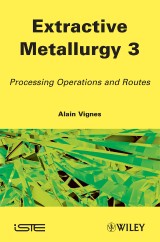Details

Extractive Metallurgy 3
Processing Operations and Routes1. Aufl.
|
149,99 € |
|
| Verlag: | Wiley |
| Format: | EPUB |
| Veröffentl.: | 01.03.2013 |
| ISBN/EAN: | 9781118617021 |
| Sprache: | englisch |
| Anzahl Seiten: | 352 |
DRM-geschütztes eBook, Sie benötigen z.B. Adobe Digital Editions und eine Adobe ID zum Lesen.
Beschreibungen
Extractive metallurgy is the art and science of extracting metals from their ores and refining them. The production of metals and alloys from these source materials is still one of the most important and fundamental industries in both developed and developing economies around the world. The outputs and products are essential resources for the metallic, mechanical, electromagnetic, electrical and electronics industries (silicon is treated as a metal for these purposes).<br /> This series is devoted to the extraction of metals from ores, concentrates (enriched ores), scraps, and other sources and their refining to the state of either liquid metal before casting or to solid metals. The extraction and refining operations that are required may be carried out by various metallurgical reaction processes.<br /> <br /> <p>Extractive Metallurgy 1 deals with the fundamentals of thermodynamics and kinetics of the reaction processes. Extractive Metallurgy 2 focuses on pyrometallurgical, hydrometallurgical, halide and electro-metallurgical (conversion) processes. Extractive Metallurgy 3 deals with the industrial processing operations, technologies, and process routes, in other words the sequence of steps or operations used to convert the ore to metal. Processes and operations are studied using the methodology of “chemical reaction engineering”.</p> <p>As the fundamentals of the art and science of Extractive Metallurgy are infrequently taught as dedicated university or engineering schools courses, this series is intended both for students in the fields of Metallurgy and Mechanical Engineering who want to acquire this knowledge, and also for engineers put in charge of the operation of an industrial production unit or the development of a new process, who will need the basic knowledge of the corresponding technology.</p>
<p>Preface xi</p> <p><b>Chapter 1. Physical Extraction Operations 1</b></p> <p>1.1. Solid-solid and solid-fluid separation operations 1</p> <p>1.2. Separation operations of the components of a fluid phase 5</p> <p>1.3. Bibliography 12</p> <p><b>Chapter 2. Hydrometallurgical Operations 15</b></p> <p>2.1. Leaching and precipitation operations 15</p> <p>2.2. Reactor models based on particle residence time distribution functions 24</p> <p>2.3. Reactor models based on the population balance equation model 30</p> <p>2.4. Solvent extraction operations 34</p> <p>2.5. Bibliography 43</p> <p><b>Chapter 3. Gas-solid and Solid-solid Reactors and Particle Conversion Operations 45</b></p> <p>3.1. Overall presentation of gas-solid and solid-solid reactors 45</p> <p>3.2. Gas-solid reactor hydrodynamic behavior and heat transfer between phases 47</p> <p>3.3. The performance equations of gas-solid packed-bed reactors 55</p> <p>3.4. The performance equations of fluidized-bed reactors 65</p> <p>3.5. Solid-solid reactors 73</p> <p>3.6. Bibliography 77</p> <p><b>Chapter 4. Blast Furnaces 79</b></p> <p>4.1. Overview of blast furnaces 79</p> <p>4.2. Iron blast furnace 81</p> <p>4.3. Ferromanganese blast furnace 109</p> <p>4.4. Zinc blast furnace: the Imperial smelting furnace 114</p> <p>4.5. Lead blast furnace 120</p> <p>4.6. Bibliography 122</p> <p><b>Chapter 5. Smelting Reduction Operations 125</b></p> <p>5.1. Overview of smelting reduction operations 125</p> <p>5.2. Production of (iron) “hot metal” by carbothermic smelting reduction 126</p> <p>5.3. Tin and zinc smelting reduction operations 139</p> <p>5.4. Magnetherm process 146</p> <p>5.5. Bibliography 148</p> <p><b>Chapter 6. Steelmaking Operations 151</b></p> <p>6.1. Overview of steelmaking operations 151</p> <p>6.2. Hot metal pretreatment operations 153</p> <p>6.3. The hot metal converting operation 154</p> <p>6.4. Stainless steelmaking operations 174</p> <p>6.5. Ultra-low carbon steel-making operation 179</p> <p>6.6. Bibliography 183</p> <p><b>Chapter 7. Sulfide and Matte Smelting and Converting Operations 185</b></p> <p>7.1. Overview of the operations and processes 185</p> <p>7.2. Flash-smelting operations and processes 188</p> <p>7.3. In-bath smelting and converting operations in bottom-blown converters 195</p> <p>7.4. In-bath smelting and converting operations in top-blown converters 203</p> <p>7.5. Top-submerged lance (TSL) blown converters: Ausmelt/Isasmelt process 208</p> <p>7.6. Bibliography 213</p> <p><b>Chapter 8. Electric Melting and Smelting Furnaces 217</b></p> <p>8.1. Introduction 217</p> <p>8.2. Performance of electric furnaces 220</p> <p>8.3. Electric arc melting furnaces 235</p> <p>8.4. Electric smelting reduction furnaces 240</p> <p>8.5. Consumable-electrode remelting furnaces 257</p> <p>8.6. Bibliography 261</p> <p><b>Chapter 9. Molten Salt Electrolysis Operations 265</b></p> <p>9.1. Overview of molten salt electrolysis operations 265</p> <p>9.2. Chloride electrolysis 266</p> <p>9.3. Reduction of alumina by electrolysis 271</p> <p>9.4. Electro-reduction of metal oxides and deoxidation of metals by molten salt electrolysis 286</p> <p>9.5. Bibliography 289</p> <p><b>Chapter 10. Extractive Processing Routes 293</b></p> <p>10.1. Features of extractive processing routes 293</p> <p>10.2. Hot metal, steel and ferroalloys 296</p> <p>10.3. Aluminum (gallium) 298</p> <p>10.4. Copper and other valuable metals 300</p> <p>10.5. Nickel (cobalt) 304</p> <p>10.6. Zinc (cadmium, indium, germanium, gallium) 311</p> <p>10.7. Lead (silver, gold, bismuth) 314</p> <p>10.8. Tin 316</p> <p>10.9. Magnesium 318</p> <p>10.10. Titanium, zirconium and hafnium 318</p> <p>10.11. Chromium 321</p> <p>10.12. Molybdenum and tungsten 321</p> <p>10.13. Niobium and tantalum 322</p> <p>10.14. Gold 323</p> <p>10.15. Metals belonging to the PGM 324</p> <p>10.16. Silicon 324</p> <p>10.17. Bibliography 325</p> <p><b>List of Symbols 329</b></p> <p><b>Index 341</b></p> <p><b>Summaries of Other Volumes 353</b></p>
"The books are addressed to students in the field of metallurgy and to engineers facing the problem of metal and alloy development." (World of Metallurgy, 2011) <p> </p>
<p><strong>Alain Vignes</strong> was Professor of Metallurgical Reaction Engineering at the School of Mines of Nancy in France, then Professor and Director of the Materials Research Center of the School of Mines of Paris. He was then Chief Metallurgist for the French Nuclear Power Company (today AREVA NP).

















